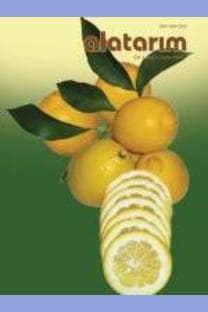Organik turunçgil yetiştiriciliğinde yabancı ot mücadelesinde örtücü bitkilerden yararlanma olanakları
Organik turunçgil bahçesinde örtücü bitki olarak buğdaygillerden Hordeum vulgare L. (Arpa) ve Lolium italicum A. Braun. (İtalyan çimi), baklagillerden Vicia sativa L. (Adi fiğ) ve Trifolium resupinatum L. (Acem üçgülü) Mersin (Erdemli)’de ekilmiş ve geleneksel yabancı ot mücadelesine göre yabancı ot yoğunluğunu ne ölçüde baskıladığı araştırılmıştır. Denemenin 2004–2005 kış sezonunda örtücü bitkiler içerisinde yabancı ot kaplama alanı yönünden en düşük değerler %0.2 ile arpa ve %1 ile adi fiğden elde edilmiştir. Yabancı ot yoğunluğu yönünden ise en düşük değerler arpa ve adi fiğde sırası ile 5.1 ve 8.5 adet/$M^2$ olarak belirlenmiştir. Örtücü bitki kaplama alanı arpa ve fiğde sırasıyla %88 ve %86 olurken bu değer çim için %72 ve acem üçgülü için %70 olarak saptanmıştır.En yüksek yaş ağırlık değeri (4182.0 kg/da) adi fiğden alınırken yabancı otlu entegre parselinde bu değer 3077 kg/da olarak saptanmıştır. Ancak kurak geçen 2006-2007 kış sezonunda yabancı ot kaplama alanı acem üçgülü ve çim için sırası ile %5.70 ve %9.8 olarak belirlenirken, yabancı ot yoğunluğu yönünden en düşük değerler ise yine acem üçgülü (15.25 adet/m2) ve çimden (31.8 adet/$M^2$ elde edilmiştir. Örtücü bitki kaplama alanı üçgül ve çimde sırasıyla %82.9 ve %71.6 olurken bu değerler arpa ve adi fiğ için %64.0 olarak belirlenmiştir. En yüksek yaş ağırlık değeri (2482.0 kg/da) yine adi fiğden alınırken yabancı otlu entegre parselinde ise bu değer 3688.0 kg/da olarak saptanmıştır. Çalışmada; kültür bitkilerinin toprağı kaplama alanı ile genel yabancı otlanma arasında negatif bir ilişki olduğu saptanmıştır. Organik turunçgil yetiştiriciliğinde sorun olan yabancı otları kontrol altında tutabilmek amacı ile örtücü bitkilerden yararlanılabilecektir.
Anahtar Kelimeler:
yabancı ot savaşımı, organik tarım, yer örtücü bitkiler, baskınlık, bitki örtüsü, turunçgiller, yabancı otlar
The opportunities to benefit from some cover crops to control weeds in organic citrus cultivation
Hordeum vulgare L. (barley) from Poaceae family, Lolium italicum A. Braun. (Italian grass), Vicia sativa L. (common vetch) from leguminosae and Trifolium resupinatum L. (persian clover) were grown as a cover crop and it was investigated how much they hold down the weeds intensity compare to conventional application in organic citrus orchards at Mersin (Erdemli) province, Turkey. The experiment of 2004-2005 winter season, while the least values were found as a 0.2% from barley and (1%) was found from the common vetch among the cover crops. The least values was determined from the barley and common wetch, 5.1 and 8.5 number/$M^2$ respectively in the respect of weed intensity. Although plant covering area of barley and common wetch were detected as 88% and 72% respectively, plant covering area of Persian clover was found 70%. While the highest fresh weight (4182.0 kg/da) was determined on common wetch in integrated pest management plot, this value was found as 3077 kg/da from integrated pest management parcel with weed. But, it was obtained that weed covering area was found in persian clover and grass as 5.70% and 9.8% respectively, the least values were found from persian clover (15.25 number/$M^2$) and grass (31.8 adet/m2) regarding weed intensity in dried 2006-2007 winter. Persian clover and grass ground covering area were found 82.9 % and 71.6% respectively, but these values were determined %64.0 for barley and common vetch.The highest fresh weight value (2482.0) was found from common vetch, this value was determined on integrated pest management weed plot as 3688.0 kg/da. In this study, there was found a negative relationship between the cultivated plants soil covering area and weed growth. The result of this study showed that to control weeds which are problem in organic citrus cultivation, groundcover plants are able to grow without any cost.
Keywords:
weed control, organic farming, ground cover plants, dominance, cover crops, Citrus, weeds,
___
- Altieri, M.A., Farrel, J.G., Hecht, S.B., Liebman, M., Magdoff, F., Murhy, B., Norgaard, B.,Sikor, T.O., 1989. Cover Cropping and Mulching. The Science of Sustainable Agriculture. Westview Press, 433 p.
- Bordelon, B. P., Weller, S. C., 1997. Preplant Cover Crops Affect Weed and Vine Growth in First-Year Vineyards. HortScience, 32(6) 1040-1043.
- Elekçioğlu, N., Pala, H., Temel, N., Özarslandan, A., 2008. Doğu Akdeniz Bölgesi’nde Organik Turunçgil Üretiminde Hastalık, Zararlı Ve Yabancı Otların Mücadelesinin Yönetimi TAGEM BS-03/06-09-175 nolu Proje Sonuç Raporu. Zirai Mücadele Araştırma Enstitüsü, Adana.
- Fisk, J.W., Hesterman, O.B., Shrestha, A., Kells, J.J., Harwood, R.R., Squire, J.M., Sheaffer, C.C., 2001. Weed Supression by Annual Legume Cover Crops in No-Tillage Corn. Agronomy Journal, 93, March-April 2001, 319-325.
- Gönen, O., Üremiş, İ., Orel, E., 1997. Weed Control Methods in Integrated Pest Management of Citrus in Adana and İçel Provinces of Türkey. Brighton Conference. 17- 20 November 1997, UK.
- Haris, R.E., 1986. Cover Crops for Western Cape Orchards. Deciduous Fruits Grower. 36(9)359-362.
- Hoffman, M.L., Regnier, E.E., Cardina, J., 1993. Weed and Corn (Zea mays) Responses to Hairy Vetch (Vicia villosa) Cover Crop. Weed Tecnology, 7:594-599.
- Kolören, O., 2004. Turunçgil Bahçelerinde Yabancı Otlar İle Mücadelede Örtücü Bitkilerin Kullanılma Olanaklarının Araştırılması. Ç. Ü. Fen Bilimleri. Enstitüsü Bitki Koruma Anabilim Dalı, Doktora Tezi 173 s.
- Kün, E., 1983. Serin İklim Tahılları. Ankara Üniversitesi, Ziraat Fakültesi Yayınları No: 875, Ders Kitabı: 240, Ankara.
- Mohler, C.L., Liebman, M., 1987. Weed Productivity and Composition in Cole Crops and Intercrops of Barley and Field Pea. Journal of Applied Ecology 24: 685-699.
- Swisher, M.E., Monaghan, P., Ferguson, J., 1993. A Profile of Florida’s Commercial Organic Citrus Growers.
- Uygur, F.N., 1985 Untersuchungen zu Art und Bedeutung der Verunkrautung In der Çukurova Unter besonderer Berücksichtigung von Cynodon dactylon (L.) Pers. Und Sorghum halepense (L.) Pers. PLITS, 1985/3 (5), Stuttgart, 169 s.
- ISSN: 1304-2653
- Başlangıç: 2015
- Yayıncı: Alata Bahçe Kültürleri Araştırma Enstitüsü
Sayıdaki Diğer Makaleler
Elma klon anaçlarında iç mekan aşılarının uygulanabilirliği üzerine araştırmalar
Şerif ÖZONGUN, Enver Murat DOLUNAY, Mustafa PEKTAŞ, Gökhan ÖZTÜRK
Nazife TEMEL, Serdar EYMİRLİ, MUSTAFA AVCI
Adana kentinde parklardaki bazı süs bitkilerinde bulunan Thysanoptera (Thrips) türleri
Hasan PINAR, Veysel ARAS, Davut KELEŞ, MUSTAFA ÜNLÜ, Nedim MUTLU
